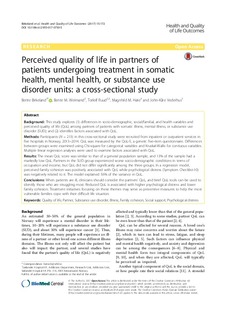| dc.contributor.author | Birkeland, Bente | |
| dc.contributor.author | Weimand, Bente M. | |
| dc.contributor.author | Ruud, Torleif | |
| dc.contributor.author | Høie, Magnhild M. | |
| dc.contributor.author | Vederhus, John-Kåre | |
| dc.date.accessioned | 2018-03-20T11:38:58Z | |
| dc.date.available | 2018-03-20T11:38:58Z | |
| dc.date.created | 2017-08-31T17:38:30Z | |
| dc.date.issued | 2017 | |
| dc.identifier.citation | Birkeland, B., Weimand, B. M., Ruud, T., Høie, M. M., & Vederhus, J.-K. (2017). Perceived quality of life in partners of patients undergoing treatment in somatic health, mental health, or substance use disorder units: a cross-sectional study. Health and Quality of Life Outcomes, 15: 172. doi: | nb_NO |
| dc.identifier.issn | 1477-7525 | |
| dc.identifier.uri | http://hdl.handle.net/11250/2491233 | |
| dc.description.abstract | Background: This study explores (1) differences in socio-demographic, social/familial, and health variables and perceived quality of life (QoL) among partners of patients with somatic illness, mental illness, or substance use disorder (SUD); and (2) identifies factors associated with QoL.
Methods: Participants (N = 213) in this cross-sectional study were recruited from inpatient or outpatient services in five hospitals in Norway, 2013-2014. QoL was measured by the QoL-5, a generic five-item questionnaire. Differences between groups were examined using Chi-square for categorical variables and Kruskal-Wallis for contiuous variables. Multiple linear regression analyses were used to examine factors associated with QoL.
Results: The mean QoL score was similar to that of a general population sample, and 13% of the sample had a markedly low QoL. Partners in the SUD group experienced worse socio-demographic conditions in terms of occupation and income, but QoL did not differ significantly among the three groups. In a regression model, perceived family cohesion was positively associated with QoL while psychological distress (Symptom Checklist-10) was negatively related to it. The model explained 56% of the variance in QoL.
Conclusions: When patients are ill, clinicians should consider the partners' QoL, and brief QoL tools can be used to identify those who are struggling most. Reduced QoL is associated with higher psychological distress and lower family cohesion. Treatment initiatives focusing on these themes may serve as preventive measures to help the most vulnerable families cope with their difficult life situation. | nb_NO |
| dc.language.iso | eng | nb_NO |
| dc.publisher | BioMed Central | nb_NO |
| dc.rights | Navngivelse 4.0 Internasjonal | * |
| dc.rights.uri | http://creativecommons.org/licenses/by/4.0/deed.no | * |
| dc.title | Perceived quality of life in partners of patients undergoing treatment in somatic health, mental health, or substance use disorder units : A cross-sectional study | nb_NO |
| dc.type | Journal article | nb_NO |
| dc.type | Peer reviewed | nb_NO |
| dc.description.version | publishedVersion | nb_NO |
| dc.rights.holder | © 2019 The Author(s) | |
| dc.source.volume | 15 | nb_NO |
| dc.source.journal | Health and Quality of Life Outcomes | nb_NO |
| dc.identifier.doi | 10.1186/s12955-017-0750-5 | |
| dc.identifier.cristin | 1490266 | |
| dc.source.articlenumber | 172 | |
| cristin.qualitycode | 1 | |

